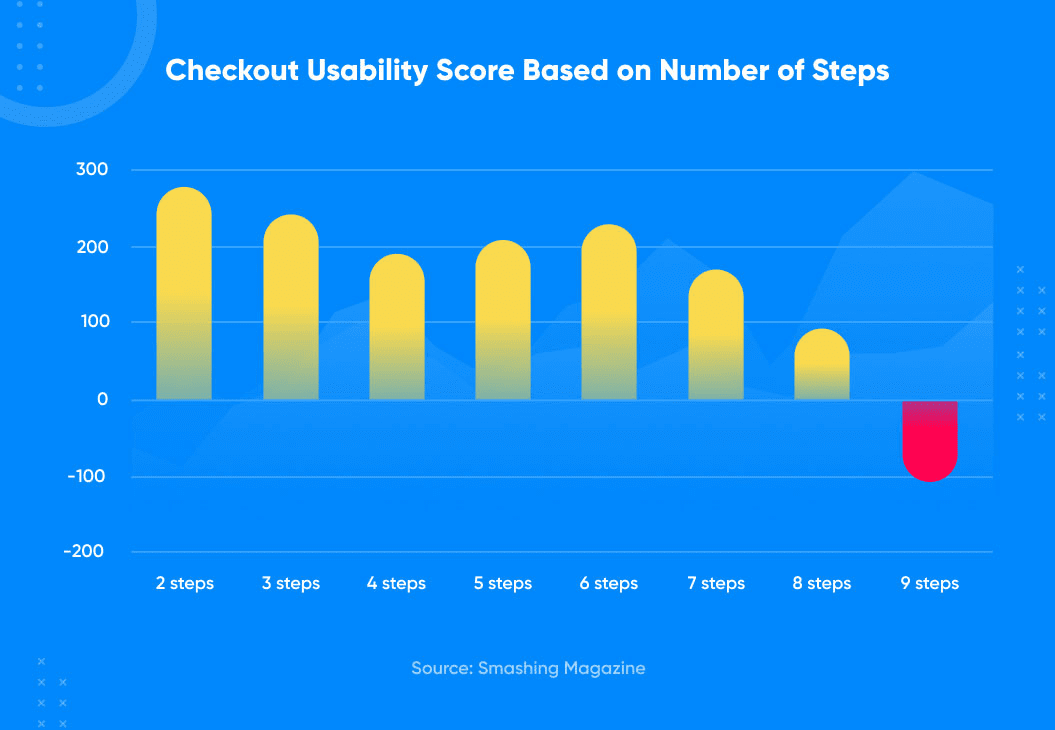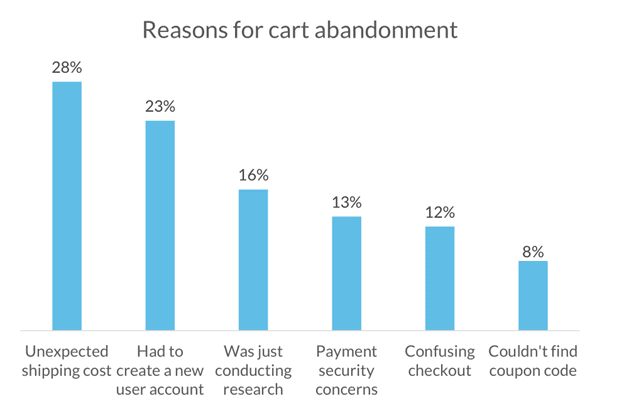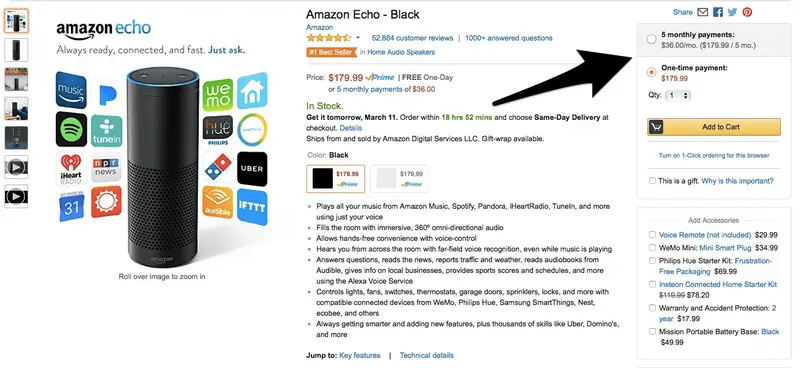Some estimates say up to 70% of online shoppers who add items to their shopping carts leave the page before completing their orders.
That’s a worrying statistic for anyone in ecommerce. But even worse than that, abandoned carts have many more damaging effects on online stores. For instance, cart abandonment skews data and reduces your conversion rates. It also drives up customer acquisition costs.
That’s why it’s worth taking the time to look at what causes people to abandon their carts, as well as what steps you can take to combat the problem.
This guide contains 10 strategies that you can use to proactively reduce online shopping cart abandonment by taking care of the problem at its source.
What is shopping cart abandonment?
Shopping cart abandonment is an ecommerce term for when a visitor on a webpage starts the checkout process for an online order but leaves the page before completing the purchase.
The products that were placed in the online shopping cart but never made it through the transaction are considered to be “abandoned” by the potential customer.
How to calculate the shopping cart abandonment rate:
The shopping cart abandonment rate can be calculated as follows:
Total number of completed purchases/ Total number of carts that were created
Multiply the result by 100 and this will give you the percentage of the website’s users that signal buying intent by placing items in their cart but drop out of the process before finishing the transaction.
Subtract this from 100% and you’ll get the actual cart abandonment rate.
So, for instance:
- If you have 100 completed transactions this month, and 150 total shopping carts created, you divide 100 by 150 to get 0.66.
- Multiply that by 100 to get 66%.
- 100% – 66% is 34%, your cart abandonment rate.
This rate is an important metric to keep track of since a high cart abandonment rate could signal things such as a poor user experience (UX), a site that’s hard to navigate, or a broken sales funnel.
Reducing the cart abandonment rate allows ecommerce businesses to experience more sales and revenue, which is why it’s so important to optimize the checkout flow. With a sales revenue calculator you can estimate how many sales you could expect and thus use this information for business planning and budgeting.
But, that’s not the only thing you can do.
In addition to focusing on getting more customers to go through with their purchases, you can also implement strategies to retarget the ones who do abandon their shopping carts so you can convert more of them into customers even after they’ve left your site.
We’re going to look at the strategies for that in a minute, but first, here are the most common reasons for shopping cart abandonment.
Common reasons for shopping cart abandonment
- High additional costs (shipping, taxes, etc.)
- Conducting research to buy later
- Being forced to create a new user account
- Concerns about payment security
- Inability to find coupon codes
- Long and complex checkout
- No express shipping available
- Return policy not satisfactory
- The website has bugs, errors, or crashes
- Lack of customer support
- Not enough payment options
- Prices displayed in foreign currency
- Better pricing on other ecommerce sites
- Site not mobile-friendly
- Lack of trust in your brand
A certain amount of abandoned shopping carts is inevitable in ecommerce. But, by addressing problems like the ones outlined above at the source, and putting in place effective retargeting strategies to re-engage customers, you can fight cart abandonment and boost your business’s bottom line.
Check analytics data to find causes
Before you can start reducing your online shopping cart abandonment rates, you must first find the causes of all your problems, and the first step in addressing this complex issue is to come up with hypotheses as to why your website visitors are leaving products in their carts.
- You can do this by conducting user research or surveys.
- You might even compare your checkout flow against competing websites.
However, an easier way is to take a look at your analytics data to identify dropoff points.
This will help you generate a hypothesis, after which you can test different solutions on your website through A/B or split testing to find out if a proposed solution might improve your cart abandonment rate.
When you can create a hypothesis for why visitors abandon their shopping carts and test your ideas for improving your sales funnel, you can constantly improve your ecommerce site’s conversion rate and increase revenues without having to focus on spending more on acquiring new customers.
If you’re doing this on a large scale, such as an enterprise company, a data integration tool may help you tie all of the analysis to one dashboard which can make diagnosing issues much easier.
10 strategies to reduce online shopping cart abandonment
Now that you’re familiar with the many reasons why customers abandon their carts, it’s time to focus on the strategies to not only reduce shopping cart abandonment but also convert customers who leave items behind.
The factors that drive online shoppers away vary according to different brands, industries, and the type of customer you attract. So, some of these solutions will work better than others depending on your business.
Just remember, whichever strategies you choose, make sure you implement a two-pronged approach that will tackle both problems:
- Reducing shopping cart abandonment: Take proactive measures to get more people to go through with their purchase of the adding items to a cart;
And,
- Recovering abandoned carts: Take reactive action to help you attract customers back who left your site before completing the checkout process.
1. Simplify the checkout process
Sometimes customers abandon their cart soon after adding items to it and never make it all the way to the checkout page. This is “cart” abandonment.
However, oftentimes, customers will drop out after initiating the checkout process, which results in “checkout” abandonment.
Complexity is one of the main reasons why online shoppers abandon the checkout flow.
The image below shows the usability score based on the number of steps added to a checkout process:

As you can see, a checkout with just two steps gets the highest conversions.
Why?
People’s attention spans are shorter than ever. No one has time to endure a complex or time-consuming checkout process, and that results in high cart abandonment rates.
You can avoid this problem by making your checkout process as simple and painless as possible.
You need to reduce confusion by improving your shopping cart UX and eliminate friction points where visitors experience unexpected roadblocks, such as having to jump through a lot of hoops to make their purchase.
Although this may seem like an overblown problem, it’s crucial not to underestimate it.
Keep in mind that 70% of users will not complete an online form that has too many fields on it. In the same way, potential customers will drop off with every additional step in your conversion funnel.
Tips to help you streamline your checkout UX:
- Only ask for the information you need. Reduce form fields to make it faster and easier for visitors to complete their purchases.
- Offer guest checkout. This helps to simplify the process and allows people to control how much information to share.
- Use an intuitive cart. This will help customers know what to do next and guide them on the purchase path when they are ready to check out.
- Make your shopping cart easy to find. Minimize the number of clicks required to get to check out, and consider using a cart slider to remove additional steps to checkout.
- Offer express checkout. This can help to speed up the transaction. Automatically identify customers with accounts and provide quick-pay options.
- Add a progress bar. If you must have a long checkout process, add a progress bar so shoppers have a visual indicator of how close they are to completing their purchase.
- Keep your CTAs simple. Don’t use clever language such as “Give it to me” or “Get this today”, instead of “Buy Now” or “Add to Cart”. Although this type of language can help you connect with your buyers, it can also sabotage the checkout process.
And remember to consider both mobile and desktop users so your checkout is as easy as possible regardless of the devices your customers use.
2. Reduce shipping costs
High shipping costs are another reason why customers abandon their shopping carts, as evidenced by the graph below:

Visitors often get “sticker shock” when they see how much their order costs with shipping.
According to a recent study, nearly 80% of shoppers stated that free shipping was a key factor in whether or not they completed a purchase online. According to another research, about 44% of consumers didn’t complete the purchase because it wouldn’t arrive on time.
These days, a growing number of people have come to expect free shipping online, which is why seeing the shipping charge on their order is one of the many reasons why shoppers decide to leave items in their shopping carts.
One way to tackle this problem is to offer free shipping promos.
However, a lot of brands cannot offer free shipping without decimating ecommerce margins, particularly when their average order quantity is just one item.
For these brands, a great way to reduce cart abandonment while protecting their margins would be to offer free shipping for a minimum order threshold. This has the added advantage of helping you improve your average order value.
Here’s an example of a free shipping threshold in a shopping cart:

This is a great way to incentivize customers to continue shopping and increase their purchase value and it doesn’t drive customers away with the surprise shipping charge at checkout.
3. Add trust signals to the checkout flow
Yet another reason why shoppers abandon carts has to do with a lack of trust. When customers don’t feel secure checking out on your website, your conversions will suffer.
Although these days more and more people are comfortable providing their credit card information online, it’s still important to add trust signals to your checkout flow (as well as other areas of your site) to help assuage any doubt your customers might have.
Tips for adding trust signals to checkout flow:
- Add social proof to your checkout page
- Use trusted payment processors like Amazon Pay, PayPal, etc.
- Include reviews and text or video testimonials from happy customers
- Incorporate trust seals and security badges on the checkout page
- Prominently feature pictures of real people
- Include customer service contact information on the page
Another way to help allay customer concerns is to add a generous money-back guarantee or solid return policy. People will be more likely to complete their purchases if they not only trust you but also know that they can easily return the product should it not meet their needs.
Even simply updating the shopping cart button copy to “Secure Checkout” can provide customers with that extra bit of reassurance needed to get them over the hurdle.
If your theory is that abandoned carts are caused by a lack of trust in your brand, then you can implement any of the solutions outlined above and test each of them on the site to help you determine if they have a statistically significant effect on your cart abandonment rate.
4. Use intent-based incentives
Yet another way to reduce online shopping cart abandonment is to convert more users by using intent-based incentives.
Although there are many causes for shoppers who abandon their shopping carts, reducing shopping cart abandonment basically comes down to being able to improve and optimize the entire shopping cart experience.
But, even with the best shopping cart experience, if there is no intent behind the customer’s action of adding an item to their shopping cart, you won’t get a conversion.
- Sometimes customers are just browsing and have no intention of completing the purchase even when they add items to their shopping cart.
- Other times, users are on the fence and need a little nudge to get them to convert.
Either way, there are things you can do to incentivize these users to make a purchase immediately, such as offering the following intent-based incentives:
- Offering limited-time promos to create a sense of urgency
- Use scarcity tactics like limited availability to increase same-session conversions
- Offer personalized promotions based on real-time behavior
These are just a few of the minimal promotional offers that you can use to encourage conversions from the visitors you identify who are about to abandon their shopping carts.
Use them to capitalize on those critical moments of conversion when your prospective customers are actively engaged with your brand and are building up buyer’s momentum.
5. Increase payment options
A lack of payment options is another major reason why customers drop out of the checkout process.
Most people have strong preferences for how they want to pay online and will only go through with the purchase if their preferred payment method is present.
Get rid of this problem and reduce your cart abandonment by offering the most popular payment methods preferred by your target audience, including:
- PayPal
- Amex
- GPay
- Shop Pay, etc.
In addition to offering multiple payment options, you can also implement quick-buy buttons and pre-filled form fields, as well as express checkout options to help make the process seamless – and eliminate yet another reason why a potential customer might take their business to your competitors.
6. Offer payment plans
As an ecommerce retailer, a high cart value is pleasing to you. But, it can lead to sticker shock for your customers, resulting in a lot of abandoned sessions.
One way to mitigate this issue is to offer interest-free payment plans. This is a great strategy to keep users from jumping ship when the price seems too high.
Here is an example of how the ecommerce giant, Amazon does this:

A lot of other retailers offer the option for paying via installments on their shopping cart page and this makes completing the order a lot easier to digest for customers who are scared of decimating their credit cards.
7. Eliminate customer journey highjacking
This happens when traffic hijackers distract your shoppers with injected ads for other competing products.
They target and lure your prospective customers with promotions and cause them to desert their carts in favor of a new shiny thing.
This not only increases your abandoned carts but also diminishes the customer’s experience on your website. For the most part, shoppers believe that the injected ads are actually a native part of your website.
You can prevent customer journey hijacking by eliminating ad injections from your customer journey. This will help you improve conversion rates and reduce cart abandonment, among other benefits.
8. Offer incentives with exit popups
Exit-intent technology allows you to track your visitors’ behavior so you know when they are about to leave your site without completing their transaction.
On desktop, you can monitor the shopper’s mouse movements, and on mobile, exit intent is triggered when the visitor either scrolls up or hits the “back” button.
Either way, when this happens, you can use exit pop-ups to help you recover abandoned carts by delivering targeted messages with offers like:
- Special discounts
- Offer to download premium content/free trial/etc.
- Invitation to chat with an agent
…and so on.
Here’s an example of an exit pop-up designed to convert abandoning visitors and grow your email subscribers and revenue:

If you’re looking to design something as good or better, consider using a graphic design tool that can help.
9. Send abandoned cart emails
Being able to effectively deal with cart abandonment goes beyond simply improving and optimizing your website’s shopping cart experience.
The strategies above are great for reducing online shopping cart abandonment, but despite your best efforts, you will still have a percentage of customers who leave your website before completing their purchase.
That’s where shopping cart recovery comes in.
It gives you an opportunity to try to capture the customer even after they have left your ecommerce website.
You can do this in two ways:
- By sending abandoned cart emails; or
- Through abandoned cart retargeting.
If prior to leaving your site, the user enters their email address, you can add them to your subscriber list and send them cart abandonment emails to entice them to return to your site and complete their purchase. This can include an offer like a discount or coupon code.
This is a simple strategy that can help you re-engage potential customers, and it’s undoubtedly effective as research has shown that 60% of shoppers return to complete a purchase 24 hours after receiving a personalized cart abandonment email.
Here are some tips to write effective abandoned cart emails:
- Grab their attention with a catchy subject line
- Create urgency by using terms like “hurry”
- Include prominent links to the cart
- Incentivize purchases with discounts, coupons, etc.
10. Use retargeting to target abandoners
Abandoned cart retargeting is another tactic to help you convince abandoners to come back and finish their purchase.
You can use ads to retarget people who’ve been on your site but left without completing their order.
To do this, you first need to place an ad pixel on your site checkout page. You’ll then be able to remarket to cart abandoners on other platforms, such as Google and Facebook. You can even create shoppable posts by allowing your audience to directly buy your product on Instagram.
The main advantage of retargeting users in this way is that it works even if they didn’t enter their email address prior to dropping out of the checkout flow.
Also, retargeting ads help you remain top of mind for those potential customers as they continue to browse the web.
Conclusion
There you have it. 10 strategies to reduce online shopping cart abandonment. Use these as an effective way to tackle high abandonment rates at the source so you don’t miss out on potential sales.
Over to you. Do you know any other strategies for solving the cart abandonment problem in ecommerce? Let us know in the comments below!




